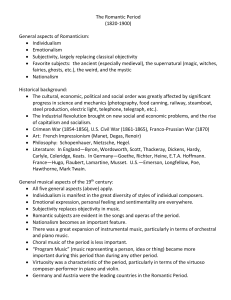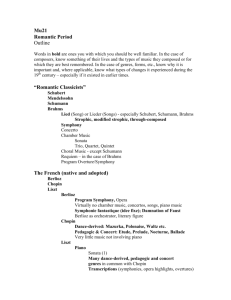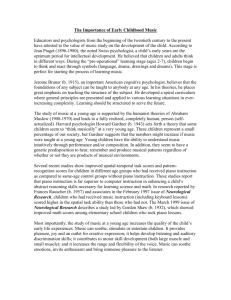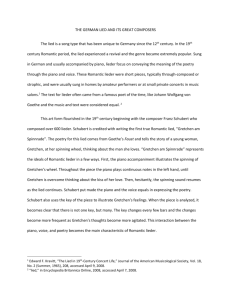HANDOUT #7: CLASSICAL MUSIC
advertisement
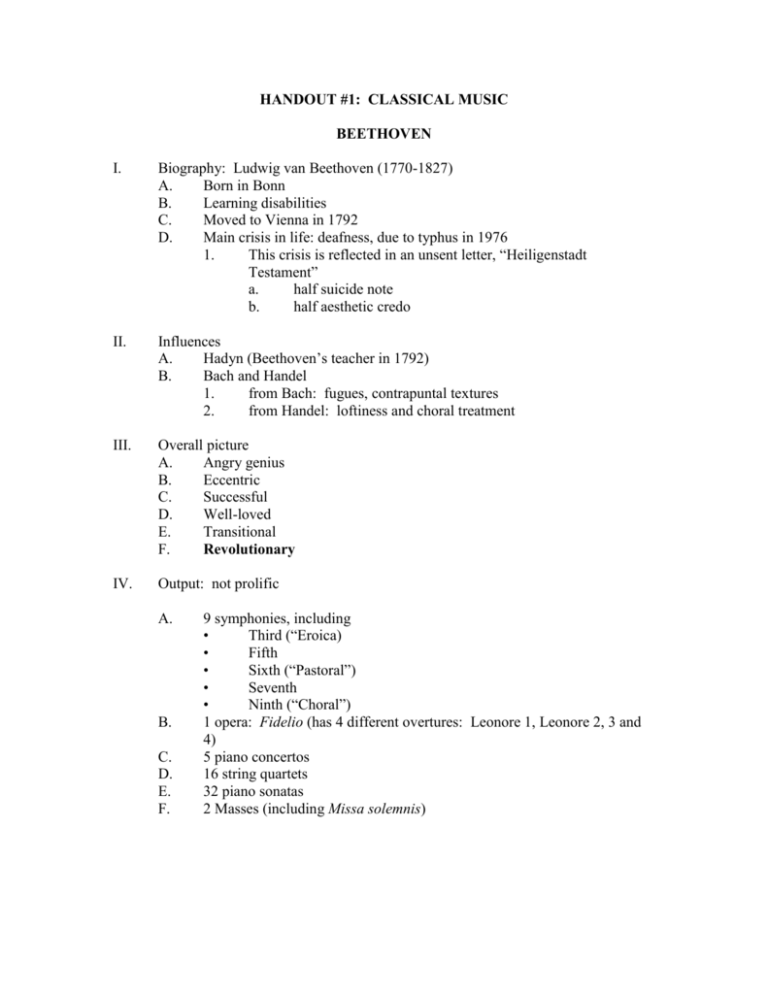
HANDOUT #1: CLASSICAL MUSIC BEETHOVEN I. Biography: Ludwig van Beethoven (1770-1827) A. Born in Bonn B. Learning disabilities C. Moved to Vienna in 1792 D. Main crisis in life: deafness, due to typhus in 1976 1. This crisis is reflected in an unsent letter, “Heiligenstadt Testament” a. half suicide note b. half aesthetic credo II. Influences A. Hadyn (Beethoven’s teacher in 1792) B. Bach and Handel 1. from Bach: fugues, contrapuntal textures 2. from Handel: loftiness and choral treatment III. Overall picture A. Angry genius B. Eccentric C. Successful D. Well-loved E. Transitional F. Revolutionary IV. Output: not prolific A. B. C. D. E. F. 9 symphonies, including • Third (“Eroica) • Fifth • Sixth (“Pastoral”) • Seventh • Ninth (“Choral”) 1 opera: Fidelio (has 4 different overtures: Leonore 1, Leonore 2, 3 and 4) 5 piano concertos 16 string quartets 32 piano sonatas 2 Masses (including Missa solemnis) V. Three style periods A. Early (“classic”): 1782 – 1802 1. resembles style of Haydn and Mozart a. Alberti bass b. short length 2. more like Haydn a. slow introduction in First Symphony, op. 21 (1800) b. weak second theme in Sonata in F minor, op. 2, #1 (1795) 3. already different, though a. he add another movement to piano sonatas (4, instead of 3) b. more passionate and intense, e.g., “Pathétique Sonata, Op. 13 (1798-9) B. Middle (“heroic”): 1802 - 1815 1. expansion via many themes, long developments and codas, enlarged instrumentation, more movements, noble 2. greater integration of movements a. SSSL of Fifth Symphony, Op. 67 (1807-8 3. More on Third Symphony (1803) a. originally, “Bonaparte” Symphony, later revised to “Eroica” (Heroic) Symphony b. watershed work: biggest symphony to date C. Late (“integration”): 1815 – 1827 1. not as “heroic”: more introspective, serene 2. abstract (more learned devices such as fugues, strettos, etc.) 3. increased use of variation 4. formal barriers break down (sonata form and variation form mesh for example in the last movement of the Ninth Symphony) 5. complete integration of material (harmonic, motivic, key) HANDOUT #2: ROMANTIC MUSIC (FINALLY!) I. Approximate Dates: A. early: 1825-1840s B. middle: 1840s-1890 C. late: 1890-1910 II. Social Background A. B. C. D. E. F. G. H. I. III. French revolution Reaction against the Enlightenment (rationalism) Key words: anti-rationalism, intensity, emotion, expression, feeling, striving Anti-rationalism gestures: 1. rise against formulism 2. rise of prose Imperialism Nationalism/Fascination with heritage (cosmopolitan art is no longer the goal) Individualism >>> artistes Obsession with the past Worship of nature, the supernatural (especially in Germany) General Characteristics of Romantic Music A. B. C. D. E. F. G. H. I. Originality More program music (less abstract) Definition of program music (Grout/Palisca): Music that is descriptive, narrative, or that develops a non-musical subject) Words are all-important More complex, chromatic harmony Freer tempos Freer (less periodic) phrase structures Larger development and coda sections in sonata forms Greater lengths of pieces, expanded forms More emphasis on tone color HANDOUT #3: ROMANTIC MUSIC Instrumental Music: Solo Piano I. The “supreme Romantic instrument” = piano II. Piano is featured in the chief types of romantic composition A. Lied B. III. IV. Character piece for piano 1. definition: a short, lyric piece for piano 2. usually evokes a particular mood or scene 3. often has descriptive titles 4. appears under a variety of names 5. is a type of program music definition of program music (Grout/Palisca): music that is descriptive, narrative, or that develops a non-musical subject Composers of character pieces A. Mendelssohn B. Field C. Chopin D. Liszt E. Schubert F. R. and C. Schumann > > > look up! > > > more on these > > > composers next class More on Chopin (1810-1849) A. Biography 1. Polish/French descent 2. settled in Paris 3. romance with George Sand (Madame Aurore Dudevant) B. Output: mostly piano music 1. 50 mazurkas 2. 16 polonaises 3. other character pieces: preludes, nocturnes, ballades, etudes 4. 3 piano sonatas 5. 2 concerti for piano and orchestra 6. 1 cello sonata and a few Polish songs C. Style: 1. lyrical, embellished, and liquid melodies 2. improvisational 3. uses rubato 4. 5. V. More on Field (1782-1837) A. Biography 1. Irish pianist 2. studied with Clementi 3. worked in Russia B. VI. definition of rubato (Grout/Palisca): advancing or delaying a beat, or slowing down and speeding up, usually for expressive effect, before restoring the regular beat or tempo. innovative (especially new sound worlds for piano: notes enter “from a distance,” uses entire keyboard) chromatic Importance 1. inspired Chopin (especially: the name, general idea, as well as specific style of nocturnes) Franz Liszt (1811-1886) A. Biography 1. great virtuosic pianist of the century 2. centered in Paris until 1848 3. court director at Weimar (1848-61) 4. father-in-law of Richard Wagner B. Output 1. symphonic poems (e.g., Les Préludes) a. definition of symphonic poem: an orchestral piece whose music is accompanied by a program (i.e., a text) b. consists of 1 movement 2. 2 program symphonies with chorus: Faust, Dante a. Definition of program symphony: an orchestral work in the form of a symphony and bearing a descriptive title or program b. consists of several movements 3. Sonata in B minor 4. character pieces, including: a. Transcendental Etudes b. Nuages gris c. Années de Pélinerinage (Yrs. of Pilgrimage) 5. Masses and oratorios HANDOUT #4: ROMANTIC MUSIC Instrumental Music: Program Symphonies, Berlioz I. Types of Program Music A. B. C. D. II. character piece program symphony symphonic poem programmatic concert overture 19th Centuries Symphonies in General A. Two paths, both originating from Beethoven 1. conventional group: Schubert, Brahms, Bruckner a. wrote absolute music b. adhered to classical forms 2. B. III. radical group: Berlioz, Liszt a. wrote programmatic music b. did not adhere to classical forms; rather, the program affected the form Some composers defy neat categorization, e.g., Schumann. More on Berlioz (1803-1869) A. B. C. Why so radical? No strong symphonic tradition in France. Radical work: Symphonie fantastique (“Episode in the Life of an Artist”) What’s so radical: 1. it’s programmatic 2. the use of an idée fixe (“fixed idea”—a recurring theme through all movements) 3. new designs a. 5 movements (rather than 4) b. order of movements is symmetrical: Allegro-Waltz-Pastoral-March-Finale (instead of F-SMinuet-F) c. internal forms deviate from tradition d. instrumentation 1) some types are associated with opera 2) new combos 3) new types of instruments not found elsewhere (e.g., saxophone, ophicleide) e. unpredictable style D. What are Berlioz’s connections to Beethoven? 1. expanded length 2. expanded instrumentation 3. use of a program 4. growth/blossoming of an idea 5. cyclicity (definition: the incorporation of a single theme into two or more movements of a multi-movement composition) HANDOUT #5: ROMANTIC MUSIC Vocal Music: Art Song, Schubert, Schumanns I. II. Art Song A. Definition: a song of serious artistic intent written by a trained composer; a chief genre of Romantic music B. Characteristics: 1. short 2. solo voice 3. piano accompaniment 4. text has high literary quality 5. strophic or through-composed KNOW!! a. definition of strophic: all the stanzas (verses) of the poem are sung to the same music C. History of Art Song 1. a product of the Romantic era, but goes back to Medieval times 2. German song is the Lied 3. French song us the mélodie 4. Why so important in the Romantic era? Due to a. development of Romantic lyric poetry by Goethe, Heine, Schiller b. popularity of the piano Franz Schubert (1797-1828) A. Biography 1. Viennese Classical composer 2. musically precocious 3. Vienna Choir Boy! 4. studied with Salieri 5. first composer to live entirely on income from compositions B. Output 1. 650 Lieder a. many performed at Schubertiaden b. most famous Lieder: 1) “The Erlking” 2) “Gretchen at the Spinning Wheel” 3) “Death and the Maiden” 4) “The Trout” 5) “Little Heath Rose” >>>>>>>> 2. many character pieces for piano, including 14 impromptus 3. 4. 5. 6. 7. 8. C. What’s so great about Schubert’s Lieder? 1. Before Schubert, Lieder a. tended to be unremarkable b. was used only very conventional harmony c. shad tock accompaniment figures 2. III. 22 piano sonatas 9 symphonies, including the Unfinished Symphony chamber works, including the Trout Quintet 6 Masses 17 operatic works song cycles KNOW!! a. definition: a group of songs with a common poetic theme or an actual story connecting all the poems b. famous Schubert song cycle: Winterreise Schubert’s Lieder, on the other hand: a. beautiful, intensely lyrical melodies b. creative and graphic piano writing c. striking use of keys, modulation, chromatic harmony d. poetry is first-rate e. dramatic dialogues between characters (a miniature opera?) Robert Schumann (1810-56) A. Biography 1. pianist: studied with Friedrich Wieck in 1828 2. turned to composition: 1830s 3. fell in love with Clara Wieck; married in 1840 4. 1849-50: increasing illness; damaged creativity 5. imaginary friends: Florestan (extrovert) and Eusebius (introvert) B. Output 1. until 1840: mostly works for piano, such as character pieces 2. 1840: year of song: a. 160 songs b. 5 song cycles, including Liederkreis (Heine), Liederkreis (Eichendorff), Dichterliebe (Heine), Frauenliebe und – leben (Chamisso) 3. C. symphonies Style Characteristics of Lieder: 1. new independence of piano part (more so than other composers) a. piano often has the same melody as vocal part 2. 3. D. IV. symbolism: e.g., wedded bliss melodies are not as tuneful; more speech-like Style Characteristics of all his music: 1. abrupt modulations (mood swings?) 2. restlessness, longing (more romantic?) 3. mystery, subtlety Clara (Wieck) Schumann (1819-96) A. Biography 1. great pianist 2. child prodigy 3. famous composer during lifetime; but compositions have only recently been rediscovered B. Output 1. piano music: variations, nocturnes, mazurkas, waltzes, scherzos 2. vocal music, too: Lieder, choral music 3. 1 piano concerto, chamber music

